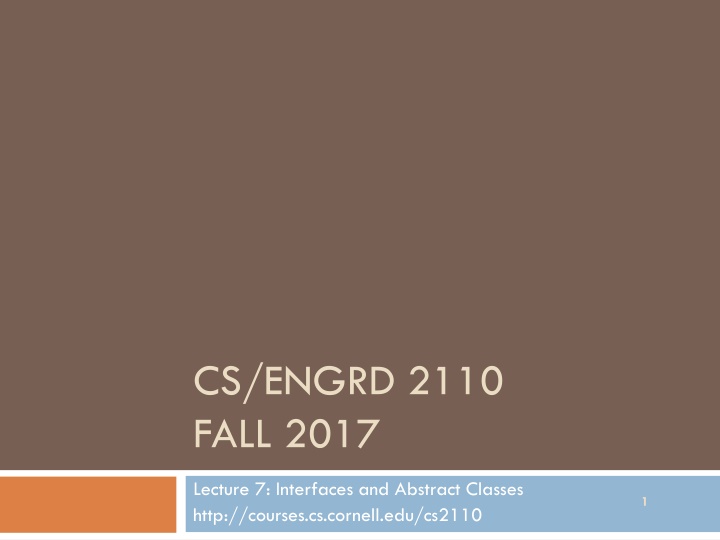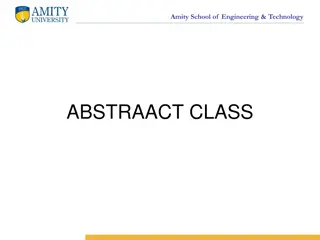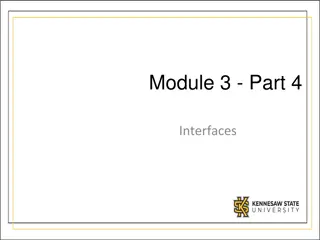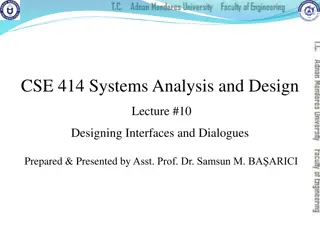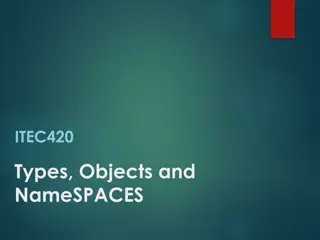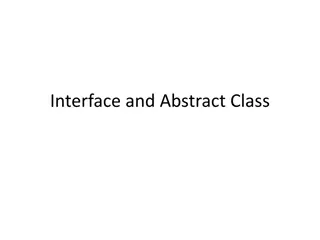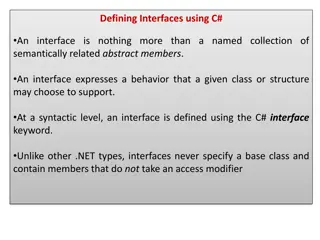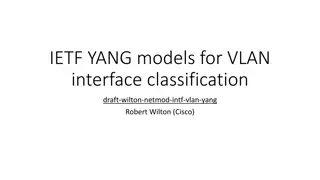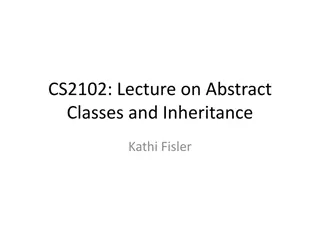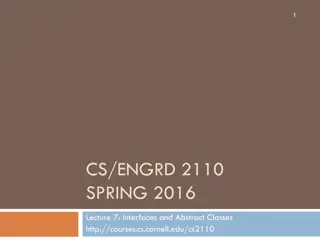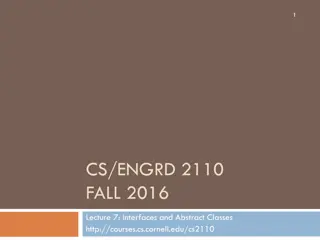Interfaces and Abstract Classes in CS/ENGRD 2110 Fall 2017
Abstract classes and interfaces play a crucial role in software design and development. This lecture covers topics such as operator instanceof, function getClass, and the concept of abstract Shape in geometry. Understand the fundamental principles behind creating abstract classes and interfaces, and their significance in object-oriented programming.
Download Presentation

Please find below an Image/Link to download the presentation.
The content on the website is provided AS IS for your information and personal use only. It may not be sold, licensed, or shared on other websites without obtaining consent from the author.If you encounter any issues during the download, it is possible that the publisher has removed the file from their server.
You are allowed to download the files provided on this website for personal or commercial use, subject to the condition that they are used lawfully. All files are the property of their respective owners.
The content on the website is provided AS IS for your information and personal use only. It may not be sold, licensed, or shared on other websites without obtaining consent from the author.
E N D
Presentation Transcript
CS/ENGRD 2110 FALL 2017 Lecture 7: Interfaces and Abstract Classes http://courses.cs.cornell.edu/cs2110 1
Announcements 2 A2 is due Sunday night (16 September) Prelim 1 is two weeks away! GO TO THE WEBPAGE: http://www.cs.cornell.edu/courses/cs2110/2018fa/exams.html Study Guide When you take the exam (where comes later) Half of you will take the exam at 5:30! The other half at 7:30! Whom to contact about conflicts READ CAREFULLY & THOROUGHLY 2
3 Go back to Lecture 6 & talk about equals
Operator instanceof and function getClass s ..@54 ..@54 Object What is s instanceof Rect ? Shape What is s.getClass() ? Rect Square 4 4
Where are we? 5 You watched 15 minutes of videos in preparation for this lecture. You learned about abstract classes and interfaces. Reason for asking you to watch it: You now have seen the technical details and have a basic understanding. We can now give examples and discuss things at greater depth than if you had not watched the videos. 5
A Little Geometry! 6 (x, y) Position of a rectangle in the plane is given by its upper-left corner (x, y) Position of a circle in the plane is given by the upper-left corner of its bounding box 6
A Little Geometry! Abstract Classes Shape Shape contains coordinates in the plane. Subclasses declare additional fields and the method area. x y Rectangle width height area() Triangle Circle base height area() radius area() 7 7
What is only a Shape, anyway?? Abstract Classes Shape Notice: An object of Shape is not really a shape. Don t want to allow creation of objects of class Shape! x y Triangle Circle Make the class abstract! base height area() radius area() Syntactic rule: if class C is abstract, the new-expression new C( ) cannot be used! public abstract class Shape { }
Writing sumAreas in class Shape Abstract Classes /** Return sum of areas of shapes in s */ public static double sumAreas(Shape[] s) { double sum= 0; for (int k= 0; k < s.length; k= k+1) sum= sum + s[k].area(); return sum; Does this work? } Compile-time reference rule says no! Solutions? 1. Use instanceof and cast down to make the call? (next slide) 2. Make area a method of Shape? 9 9
Approach 1: Cast down to make the call Abstract Classes double sum= 0; for (int k= 0; k < s.length; k= k+1) { if (sh[k] instanceof Circle) sum= sum + ((Circle) sh[k]).area(); else if (sh[k] instanceof Rectangle) sum= sum + ((Rectangle) sh[k]).area(); } return sum; or 1. Code is ugly 2. Code doesn t age well ? 10 10
Approach 2: define area in Shape Abstract Classes Add method area to class Shape: public double area() { return 0; } Problem: a subclass might forget to override area(). Problem: a subclass might still forget to override area(). Use this instead? public double area() { throw new RuntimeException( area not overridden ); } 11 11
Approach 3: Make area abstract! (Yay!) Abstract Classes In abstract class Shape, an abstract function area is required of all subclasses: public abstract class Shape { /** Return the area of this shape */ public abstract double area() ; } Syntax: If a method has keyword abstract in its declaration, use a semicolon instead of a method body. 12 12
Abstract Summary Abstract Classes 1. To make it impossible to create an instance of a class C, make C abstract: Syntax: the program cannot be compiled if C is abstract and program contains a new-expres- sion new C( ) public abstract C { } Syntax: the program cannot be compiled if a subclass of an abstract class does not override an abstract method. 2. In an abstract class, to require each subclass to override method m( ), make m abstract: public abstract int m( ) ; 13 13
Abstract class used to define a type (abstract data type, or ADT) Type: set of values together with operations on them Define type Stack (of ints). Its operations are: isEmpty() --return true iff the stack is empty push(k) --push integer k onto the Stack pop() --pop the top stack element Naturally, need specifications public abstract class Stack { public abstract boolean isEmpty(); public abstract void push(int k); public abstract int pop(); } 14
Example of Stack subclass: ArrayStack publicabstractclassStack { publicabstractboolean isEmpty(); publicabstractvoid push(int k); publicabstractint pop(); } publicclassArrayStackextendsStack { private int n; // stack elements are in private int[] b; // b[0..n-1]. b[0] is bottom Missing tests for errors! Missing specs! /** Constructor: An empty stack of max size s. */ public ArrayStack(int s) {b= new int[s];} public boolean isEmpty() {return n == 0;} publicvoid push(int v) { b[n]= v; n= n+1;} publicint pop() {n= n-1; return b[n]; } } 15
Example of Stack subclass: LinkedListStack publicabstractclassStack { publicabstractboolean isEmpty(); publicabstractvoid push(int k); publicabstractint pop(); } publicclassLinkedListStackextendsStack{ privateint n; // number of elements in stack private Node first; // top node on stack Missing tests for errors! Missing specs! /** Constructor: An empty stack */ public LinkedListStack() {} publicboolean isEmpty() {return n == 0;} publicvoid push(int v) { prepend v to list} publicint pop() { } }
publicabstractclassStack { } Flexibility! publicclassLinkedListStackextendsStack { } publicclassArrayStackextendsStack { } /** A class that needs a stack */ publicclass C { Stack st= newArrayStack(20); publicvoid m() { Choose an array implementation, max of 20 values Store the ptr in a variable of type Stack! st.push(5); } } Use only methods available in abstract class Stack 17
publicabstractclass Stack { } Flexibility! publicclassLinkedListStackextends Stack { } publicclassArrayStackextends Stack { } /** A class that needs a stack */ publicclass C { Stack st= newArrayStack(20); publicvoid m() { LinkedListStack(); Want to use a linked list instead of an array? Just change the new-expression! st.push(5); } } 18
Interfaces An interface is like an abstract class all of whose components are public abstract methods. Just have a different syntax We don t tell you immediately WHY Java has this feature, this construct. First let us define the interface and see how it is used. The why will become clear as more and more examples are shown. (an interface can have a few other kinds of components, but they are limited. For now, it is easiest to introduce the interface by assuming it can have only public abstract methods and nothing else. Go with that for now!) 19
Interfaces An interface is like an abstract class all of whose components are public abstract methods. Just have a different syntax Here is an abstract class. Contains only public abstract methods public abstract class Stack { publicabstractboolean isEmpty(); publicabstractvoid push(int k); publicabstractint pop(); } Here is how we declare it as an interface publicinterface Stack { publicabstractboolean isEmpty(); publicabstractvoid push(int k); publicabstractint pop(); } 20
Interfaces publicabstractclass Stack { publicabstractboolean isEmpty(); publicabstractvoid push(int k); publicabstractint pop(); } publicinterface Stack { boolean isEmpty(); void push(int k); int pop(); } Methods must be public and abstract, so we can leave off those keywords. Extend a class: class StackArray extends Stack { } Implement an interface: class StackArray implements Stack { } 21
A start at understanding use of interfaces Have this class hierarchy: class Animal { } class Mammal extends Animal { ... } class Bird extends Animal { } class Human extends Mammal {. } class Dog extends Mammal { } class Parrot extends Bird { } Object Animal Mammal Bird Human Dog Parrot 22
A start at understanding use of interfaces Humans and Parrots can speak. Other Animals cannot. publicvoid speak(String w) { System.out.println(w); } Object We need a way of indicating that classes Human and Parrot have this method speak Animal Mammal Bird Human Dog Parrot 23
A start at understanding use of interfaces publicinterface Speaker { void speak(String w); } Object publicclass Human extends Mammal implements Speaker { publicvoid speak(String w) { System.out.println(w); } } Speaker Animal Mammal Bird (similarly for Parrot) Human Dog Parrot 24
Heres what an object of class Human looks like publicinterface Speaker {void speak(String w); } publicclass Human extends Mammal implements Speaker { publicvoid speak(String w) { System.out.println(w); } } Usual drawing of object Draw it this way Add interface dimension Object Human@1 Animal Animal Mammal Speaker Mammal Human Human 25
Heres what an object of class Human looks like Human h= new Human(); Object ob= h; Animal a= (Animal) ob; Mammal m= h; Speaker s= h; h, ob, a, m, and w all point to the same object. The object can be (and is) cast to any partition in it: h, ob, a, m, and w. Object Upward casts: can be implicit; inserted by Java Animal Mammal Speaker Downward casts: must be explicit Human 26
A real use of interface: sorting Consider an array of Shapes: want to sort by increasing area Consider an array of ints: want to sort them in increasing order Consider an array of Dates: want to put in chronological order We don t want to write three different sorting procedures! The sorting procedure should be the same in all cases. What differs is how elements of the array are compared. So, write ONE sort procedure, tell it the function to be used to compare elements. To do that, we will use an interface. 27
Interface Comparable Package java.lang contains this interface public interface Comparable { /** = a negative integer if this object < c, = 0 if this object = c, = a positive integer if this object > c. Throw a ClassCastException if c can t be cast to the class of this object. */ int compareTo(Object c); } 28
Real example: Comparable We implement Comparable in class Shape implements Comparable public abstract class Shape { /** Return area of this shape */ public abstract double area() ; /** See previous slide*/ public int compareTo(Object c) { Shape s= (Shape) c; double diff= area() s.area(); return diff == 0 ? 0 : (diff < 0 ? -1 : 1); } If c can t be cast of Shape, a ClassCastException is thrown }
Arrays.sort has this method /** Sort array b. Elements of b must implement interface Comparable. Its method compareTo is used to determine ordering of elements of b. */ Arrays.sort(Object[] b) Shape implements Comparable, so we can write: // Store an array of values in shapes Shape[] shapes= ...; ... Arrays.sort(shapes); 30
What an object of subclasses look like public abstract class Shape implements Comparable { } public class Circle extends Shape { } public class Rectangle extends Shape { } When sort procedure is comparing elements of a Shape array, each element is a Shape. Sort procedure views it from Comparable perspective! Object Object Comparable Comparable Shape Shape Rectangle Circle 31
Abstract Classes vs. Interfaces Abstract class represents something Share common code between subclasses Interface is what something can do. Defines an abstract data type A contract to fulfill Software engineering purpose Similarities: Can t instantiate Must implement abstract methods Later we ll use interfaces to define abstract data types (e.g. List, Set, Stack, Queue, etc) 32 32
